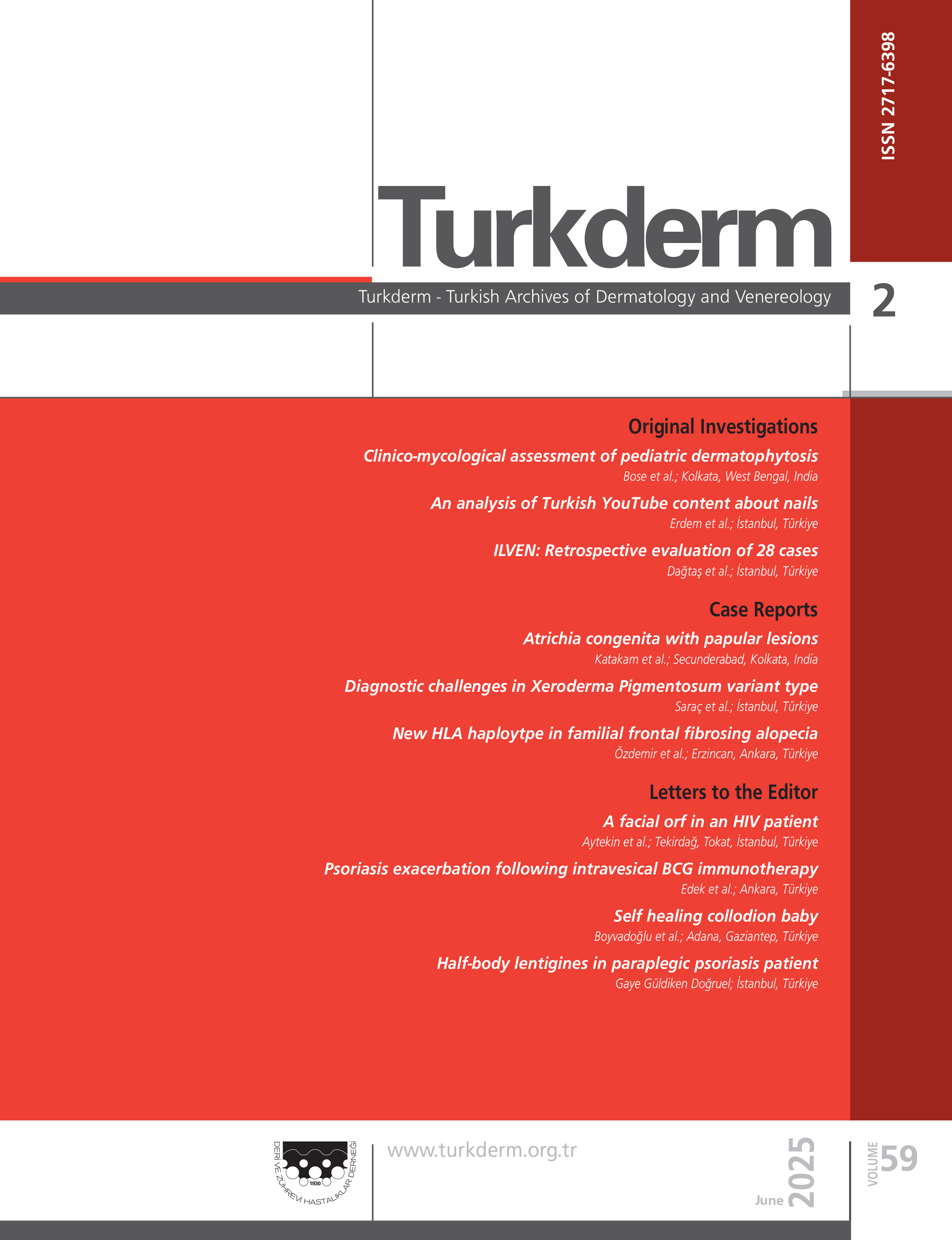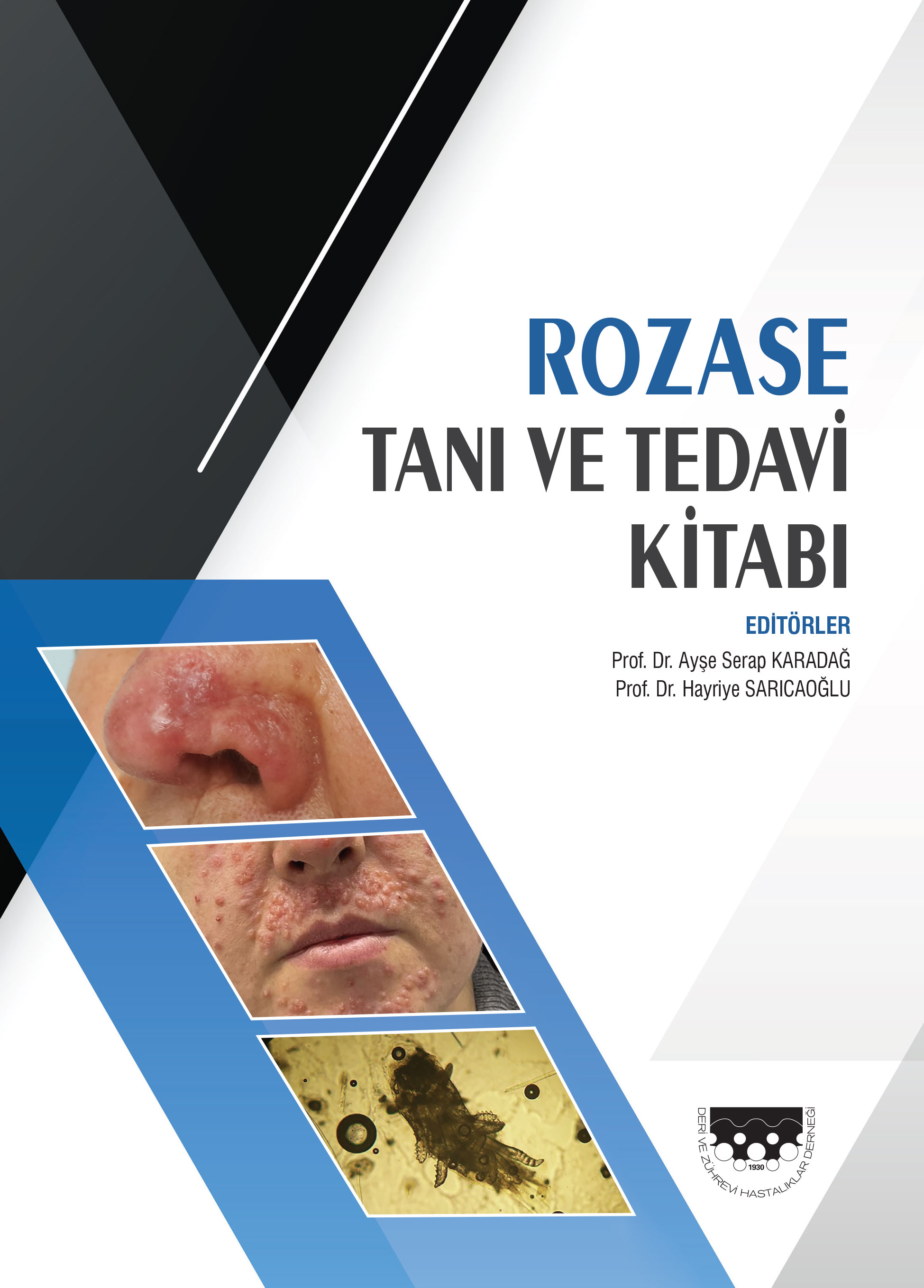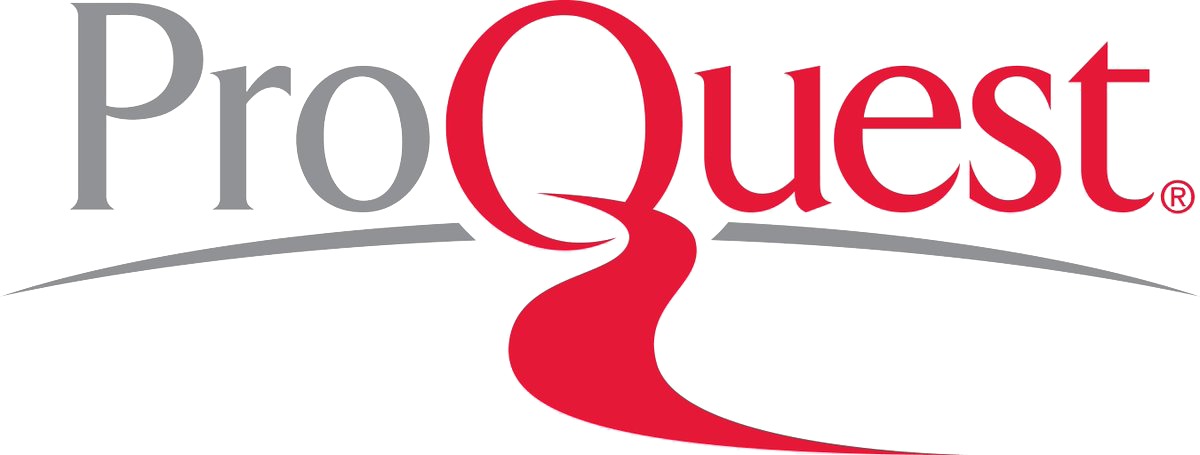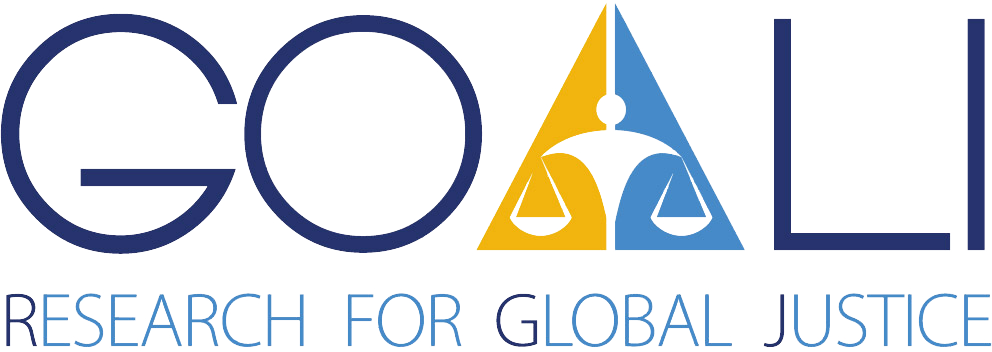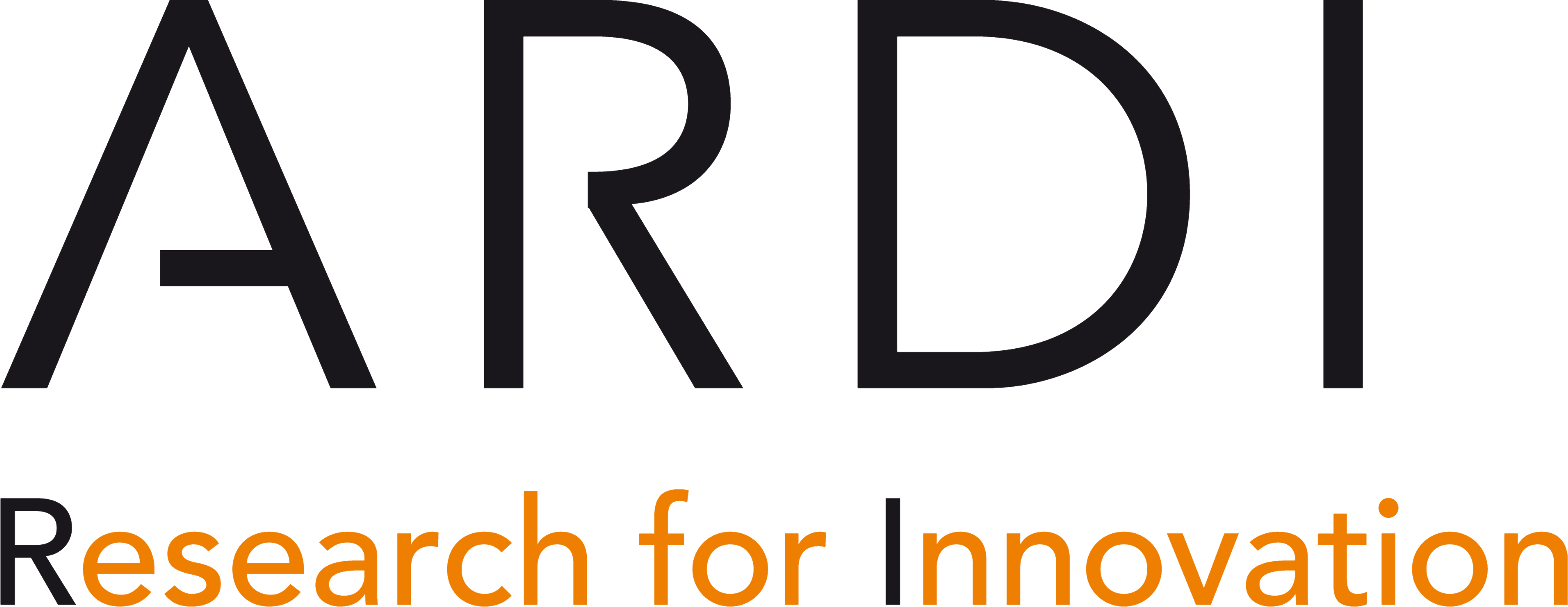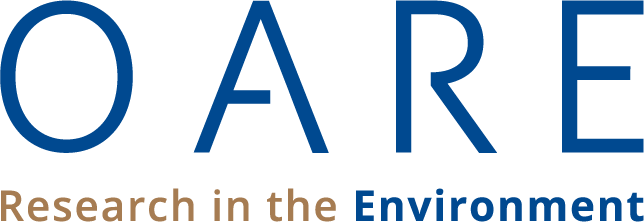Volume: 57 Issue: 3 - 2023
| 1. | Cover Pages I - VI |
| REVIEW ARTICLE | |
| 2. | What did Ottoman doctor Hüseyin Hulki (1862-1894) speak about at the first International Dermatology Congress? Mustafa Hayırlıdağ doi: 10.4274/turkderm.galenos.2023.59568 Pages 73 - 76 The first international congress for dermatology was held in Paris in 1889. This was the same year as the 100th anniversary of the French Revolution, which was being celebrated in Paris with the construction of the Eiffel Tower, a symbol of the country. Dermatology Congresses have been developing since the beginning and continue today. Dr. Hüseyin Hulki Bey is a physician who has not only contributed to the history of world medicine, but also to the history of Turkish medicine. During his attendance at the first dermatology congress, he presented an alternative treatment for syphilis than that which was known in Ottoman medicine at the time. In this study, the speech of Turkish physician Hüseyin Hulki Bey, who attended the first dermatology congress in history, is investigated. |
| ORIGINAL INVESTIGATION | |
| 3. | Factors influencing the prognosis in Braf wild-type metastatic malignant melanoma and the role of novel inflammation indices Senar Ebinç, Ziya Kalkan, Zeynep Oruç, Yasin Sezgin, Zuhat Urakçı, Mehmet Küçüköner, Muhammet Ali Kaplan, Abdurrahman Işıkdoğan doi: 10.4274/turkderm.galenos.2023.52721 Pages 77 - 82 Background and Design: This study aims to investigate the prognostic factors in BRAF wild-type metastatic cutaneous melanoma and the prognostic role of inflammation indices. Materials and Methods: Metastatic BRAF wild-type cutaneous melanoma patients who presented to our clinic between 2011 and 2021 were enrolled. To investigate their prognostic roles, age, gender, performance status, first immunotherapy regimen received by the patient, metastatic sites, and seven inflammation indices [C-reactive protein (CRP)/albumin ratio (CAR), neutrophil lymphocyte ratio (NLR), prognostic nutritional index (PNI), platelet lymphocyte ratio (PLR), systemic immune-inflammation index (SII) and advanced lung cancer inflammation index (ALI) and hemoglobin, albumin levels, lymphocyte and platelet counts (HALP)] were studied. Results: Fourty-seven patients, consisting of 22 (46.8%) females and 25 (53.2%) males, were included in this study. Mean patient age was 54 (18-88) years. In our study, there were 16 (34%) patients with liver metastasis, 17 (36.2%) patients with lung metastasis, and 9 (19.1%) patients with brain metastasis. As immunotherapy, 34 (72.3%) patients had received Nivolumab, while 13 (27.7%) patients had received Ipilimumab therapy. When the relationships of the prognostic variables with overall survival were inspected in univariate and multivariate analyses, brain metastasis was found to be an independent prognostic factor (p=0.02). Lung metastasis approached the threshold of statistical significance in univariate analysis (p=0.09) and liver metastasis in multivariate analysis (p=0.07). The seven inflammation indices examined in the analyses [CAR, NLR, PNI, PLR, SII ALI and HALP] were found to have no prognostic role in both univariate and multivariate analyses. Conclusion: Our study determined that brain metastasis is an independent poor prognostic factor in BRAF wild-type metastatic melanoma. Prognostic roles of the CAR, NLR, PNI, PLR, SII ALI and HALP indices could not be demonstrated. |
| 4. | YouTube as a source of information on Merkel cell carcinoma Abdullah Evren Yetişir doi: 10.4274/turkderm.galenos.2023.87253 Pages 83 - 86 Background and Design: To evaluate the content and reliability of Merkel cell carcinoma videos on YouTube, the most frequently used videosharing platform to access information. Materials and Methods: In this descriptive study, videos about Merkel cell carcinoma were searched on www.youtube.com using the term Merkel cell carcinoma, and 100 videos were analyzed using the Global Quality scale (GQS) and modified DISCERN tool. Results: The majority of the videos were related to treatment (72%), diagnosis (36%), and pathogenesis (19%). 81% of the videos were rated as useful and 19% as misleading. The GQS and DISCERN scores of the useful videos were statistically significantly higher than those of the misleading videos. Conclusion: The importance of YouTube, which contains both useful and misleading videos about health for public health, is increasing. Since Merkel cell carcinoma is a rare cancer, we found that the majority of the videos on this subject were uploaded by experts, and their rate of usefulness was high. In the selection of videos on health-related topics, the videos posted by experts (such as medical journals, doctors, and universities) should be prioritized, and YouTube should not be the only source of information since it has no supervisory mechanism. |
| 5. | Hidradenitis suppurativa: chronology of the onset of the disease symptoms and their gender differences: a singlecenter case series of 100 patients Kifayet Mammadlı, Aslı Bilgiç, Erkan Alpsoy doi: 10.4274/turkderm.galenos.2023.97404 Pages 87 - 93 Background and Design: The onset chronology of disease symptoms in patients with hidradenitis suppurativa (HS) and their gender differences have not yet been fully elucidated. We aimed to define the onset chronology of the disease symptoms and the socio-demographic and clinical characteristics. Materials and Methods: This single-center case series study included 100 consecutive patients. The disease symptoms for each patient were recorded in the time order of manifestations. Results: HS was more common in males (72%); 70% of the patients were overweight or obese. Smoking and alcohol consumption was significantly higher in males. The axilla was the most common onset area, followed by the inguinal and gluteal regions. The incidence of disease onset in the axilla in male and disease onset in the gluteus in female patients was significantly higher. Also, involvement of the pubis, perianal region, neck, back, and behind the ear was more common in males. The disease followed a more severe course in patients with the involvement of axilla, perianal, and inframammary areas (p<0.05). Conclusion: Besides being the most commonly involved site, axilla was the most common disease onset area in both genders; however, the incidence of disease onset in the gluteus is higher in females and the axilla in males. The male dominance observed in our cohort followed previous results reported from Türkiye, although differing from other countries. This suggests each societys unique genetic and environmental characteristics may influence the course and evolution of the disease. |
| 6. | The effect of systemic therapies on hemogram parameters and C-reactive protein in patients with psoriatic arthritis Sema Koç Yıldırım, Neslihan Demirel Öğüt, Alper Yıldırım doi: 10.4274/turkderm.galenos.2023.88614 Pages 94 - 100 Background and Design: Although some inflammatory markers were elevated in patients with psoriatic arthritis (PsA) compared to healthy controls, are few studies evaluated the effects of systemic treatments for PsA on these markers. The aim of this study is to investigate the changes in hemogram parameters and C-reactive protein (CRP) in PsA patients receiving systemic therapies. Materials and Methods: In this retrospective study, hemogram parameters, CRP, and systemic inflammation indices [neutrophil-to-lymphocyte ratio (NLR), platelet-to-lymphocyte ratio, systemic immune-inflammation index (SII), and systemic inflammation response index (SIRI)] of 50 PsA patients were analyzed before and in the third month of the treatments. Results: While mean corpuscular hemoglobin (MCH), mean corpuscular hemoglobin concentration (MCHC), and hemoglobin (Hb) were higher in the third month of all treatments compared to the baseline (p=0.009, 0.003, and 0.036, respectively), platelet, CRP and SII were lower (p=0.001, 0.000, and 0.000, respectively). In the biological therapy group (n=21), platelet, SIRI, and SII were lower, while MCHC was higher in the third month than baseline (p=0.023, 0.033, 0.000, and 0.003, respectively). CRP and SII were lower in the third month of the non-biologic treatment group (n=29) compared to the baseline, and MCH and mean corpuscular volume (MCV) were higher (p=0.001, 0.000, 0.027, and 0.044, respectively). No statistically different changes were recorded in NLR, PLR, and other parameters. Conclusion: Hb, MCH, and MCHC increased, and platelet, CRP, and SII decreased in the third month of all systemic therapies. MCV was higher in the non-biologic treatment group, and SIRI was lower in the biological treatment group in the third month than baseline. Therefore, these parameters may be useful for monitoring the effects of treatments in PsA. |
| 7. | Clinicopathological analysis of patients diagnosed with DRESS Burçin Cansu Bozca, Anıl Alpsoy, Asli Bilgiç, Cumhur İbrahim Başsorgun, Betül Ünal, Erkan Alpsoy doi: 10.4274/turkderm.galenos.2023.49207 Pages 101 - 107 Background and Design: Drug reaction with eosinophilia and systemic symptoms (DRESS) is an uncommon, but potentially fatal, adverse drug reaction. Despite the alarming statistics regarding morbidity, mortality, and hospitalizations, epidemiological data on DRESS are insufficient. In this investigation, we sought to determine the etiology, clinicopathological characteristics, and prognosis of DRESS cases at our institution. Materials and Methods: In this retrospective, single-center study, 23 patients with DRESS examined between January 2014 and September 2020 were included according to the European Registry of Severe Cutaneous Adverse Reactions (RegiSCAR) scoring system. Patients were examined between January 2014 and September 2020. Descriptive statistics, Shapiro-Wilk test, Kolmogorov-Smirnov test, Mann-Whitney U test, Pearson chi-square test, and Fishers exact test were performed. Results: The most frequently detected culprit drug category was anticonvulsants. Maculopapular eruption (100%) and elevated liver function tests (82%) were the most prevalent cutaneous and laboratory findings, respectively. Patients with elevated liver enzymes were more likely to exhibit facial erythema/edema and lymph node enlargement than those without (p=0.021 and p=0.103, respectively). The predominant pathological features were sparse vacuolization of the dermal-epidermal junction and superficial perivascular lymphohistiocytic inflammation with eosinophils. Two patients died during the period of follow-up, three patients were lost to follow-up, and eighteen patients recovered completely. Conclusion: Our research demonstrated that facial erythema/edema and lymph node enlargement are more prevalent in patients with elevated liver enzymes. Cyclosporine may be a treatment option in the fragile age group to prevent systemic corticosteroid complications. Early diagnosis and treatment that balances benefits and risks remain the most important determinants of prognosis |
| 8. | Efficacy and safety of long-pulsed alexandrite laser for the treatment of solar lentigines Şükran Sarıgül Güdük, Sadiye Kuş doi: 10.4274/turkderm.galenos.2023.21855 Pages 108 - 112 Background and Design: Various lasers, mainly nanosecond Q-switched (QS), and picosecond lasers, have been successfully used to treat solar lentigines. However, picosecond lasers are expensive, and QS lasers have a higher risk of post-inflammatory hyperpigmentation (PIH) in darker skin types. The aim of our study is to examine retrospectively the efficacy and safety of long-pulsed alexandrite laser in the treatment of solar lentigines, compare our findings to previous studies with nano and pico-second lasers, and evaluate long-term outcomes regarding recurrence. Materials and Methods: We retrospectively analyzed 39 patients with a clinical diagnosis of solar lentigo treated by long pulsed alexandrite laser. Patients photographs and clinical charts were reviewed in terms of demographic features, areas of treatment, number of sessions, laser settings, recurrence of lesions, Fitzpatricks skin type, and any side effects observed. Results: The rate of improvement was excellent in 33 (84.6%), moderate in 4 (10.2%), and mild in 2 (5.1%) patients. Seven (18%) patients with Fitzpatrick's skin type III and IV developed PIH. Lesion recurrence was observed in 5 patients (12.8%). Mean time to recurrence was 57.98±4.45 months. Conclusion: Our study suggests that long pulsed alexandrite laser is an effective and safe option in the treatment of solar lentigines. |
| 9. | Effects of the early period of the COVID-19 pandemic on psoriatic disease severity and treatment Fatma Nalbant, Ekin Şavk, Meltem Uslu, Münevver Güven doi: 10.4274/turkderm.galenos.2023.33682 Pages 113 - 118 Background and Design: The coronavirus disease-2019 (COVID-19) pandemic caused unexpected and drastic changes in the modus operandi of global healthcare. Psoriasis is a dermatosis that necessitates the provision of special healthcare services in dermatology clinics, due to its severe effects on quality of life and its socioeconomic consequences. This study aimed to identify pandemic-related problems experienced by psoriasis patients followed up in our outpatient clinic, thereby revealing the effects of the COVID-19 pandemic on these patients. Materials and Methods: This study included 64 patients with plaque psoriasis who were followed up at the Psoriasis Outpatient Clinic of Aydın Adnan Menderes University Faculty of Medicine, Department of Dermatology 6 months before and after the start of the pandemic in Turkey. A questionnaire was used to inquire how the patients were affected by the pandemic; median Psoriasis Area and Severity Index (PASI) scores and number of hospital visits were compared with pre-pandemic values. Results: Thirty-six patients (56.3%) stated that the pandemic had no effect on their disease, 20 patients (31.3%) reported a deterioration of their disease. The most common reasons thought to aggravate disease were pandemic-related stress and changes in treatment regimen. Treatment of 43 patients (67.2%) remained the same during the pandemic. There was a change in treatment in 21 patients (32.8%). The median number of patient visits to our outpatient clinic was 3 before the pandemic, which dropped to 2 during the first 6 months of the pandemic (p<0.001). PASI scores were compared on an individual basis, and 30 patients (46.9%) in the study group had an increase in their median PASI scores during the pandemic. Conclusion: The COVID-19 pandemic led to fewer patient visits to the hospital and difficulties in managing patient compliance to treatment. Our study showed that approximately half the psoriatic patients being treated had an increase in the severity of their disease during the COVID-19 pandemic. A considerable percentage of these patients linked this deterioration with the pandemic. |
| 10. | The effects of the COVID-19 pandemic on the Dermatology Outpatient Clinic of Aydın Adnan Menderes University Hospital Hilal Topyıldız, Ekin Şavk, Meltem Uslu, Münevver Güven doi: 10.4274/turkderm.galenos.2023.30676 Pages 119 - 126 Background and Design: The coronavirus disease-2019 (COVID-19) pandemic has affected the entire healthcare system in many ways. In our study, we aimed to determine how the dermatology outpatient profile was affected by the pandemic and the level of pandemic awareness. Materials and Methods: Data of patients seen at our outpatient clinic within the first 60 days prior to declaration of the pandemic in Turkey and 60 days afterward were extracted through the digital hospital database. A questionnaire with 24 questions, 8 specifically about the pandemic, were completed by 123 patients (9.3%) out of the 1,314 patients who applied to our outpatient clinic during the pandemic. Results: A total of 3,202 patients were evaluated. Of these, 1,888 (59%) were examined before and 1,314 (41%) during the pandemic. A 30.4% decrease in the number of patients was observed during the pandemic. There was also a significant increase in the male to female ratio. Psoriasis, bullous diseases, and melanoma diagnoses showed a statistically significant increase in frequency whereas acne, xerosis cutis, and nail diseases were less frequent. Female patients were more frequently affected psychologically by the pandemic (76.1% versus 53.8%) (p=0.017). Duration of dermatological complaints was shorter than 3 months in 44 (35.8%) patients, between 3 to 6 months in 12 (9.8%) and longer than 6 months in 67 (54.5%) patients. Ninety-one (74%) of the patients felt that their reason for seeking an appoinment at the dermatology outpatient clinic was urgent. There was no statistically significant relationship between the patients' opinion of whether their complaints consisted of an emergency and the duration of the skin disease (p=0.830). Conclusion: Our finding that the emergency concept of patients differs from that of medical professionals is striking. In this period of dramatic changes in the healthcare system, such as the pandemic, online technology may be beneficial for better healthcare service. |
| CASE REPORT | |
| 11. | A case of herpes zoster developing after COVID-19 vaccine and recurring after COVID-19 infection in the same dermatome Sevgi Kulaklı, Işıl Deniz Oguz, Burak Akşan doi: 10.4274/turkderm.galenos.2023.91298 Pages 127 - 129 Coronavirus disease-2019 (COVID-19) is an ongoing infectious respiratory disease recognized worldwide as a pandemic, and it can affect many organs and systems, including the skin. Various cutaneous manifestations, including reactivation of varicella-zoster virus related to COVID-19 and COVID-19 vaccination have been reported. We would like to present a 46-year-old female, who developed herpes zoster (HZ) in the right C3 dermatome after m-RNA COVID-19 vaccine and was admitted to our clinic with recurrent HZ in the same dermatome following COVID-19 infection, two months after the vaccination. |
| LETTER TO THE EDITOR | |
| 12. | Misleading nails: A case of isolated nail lichen planus resembling yellow nail syndrome Müzeyyen Gönül, Fatmanur Hacınecipoğlu, Aysun Gökçe doi: 10.4274/turkderm.galenos.2023.91370 Pages 130 - 131 |


